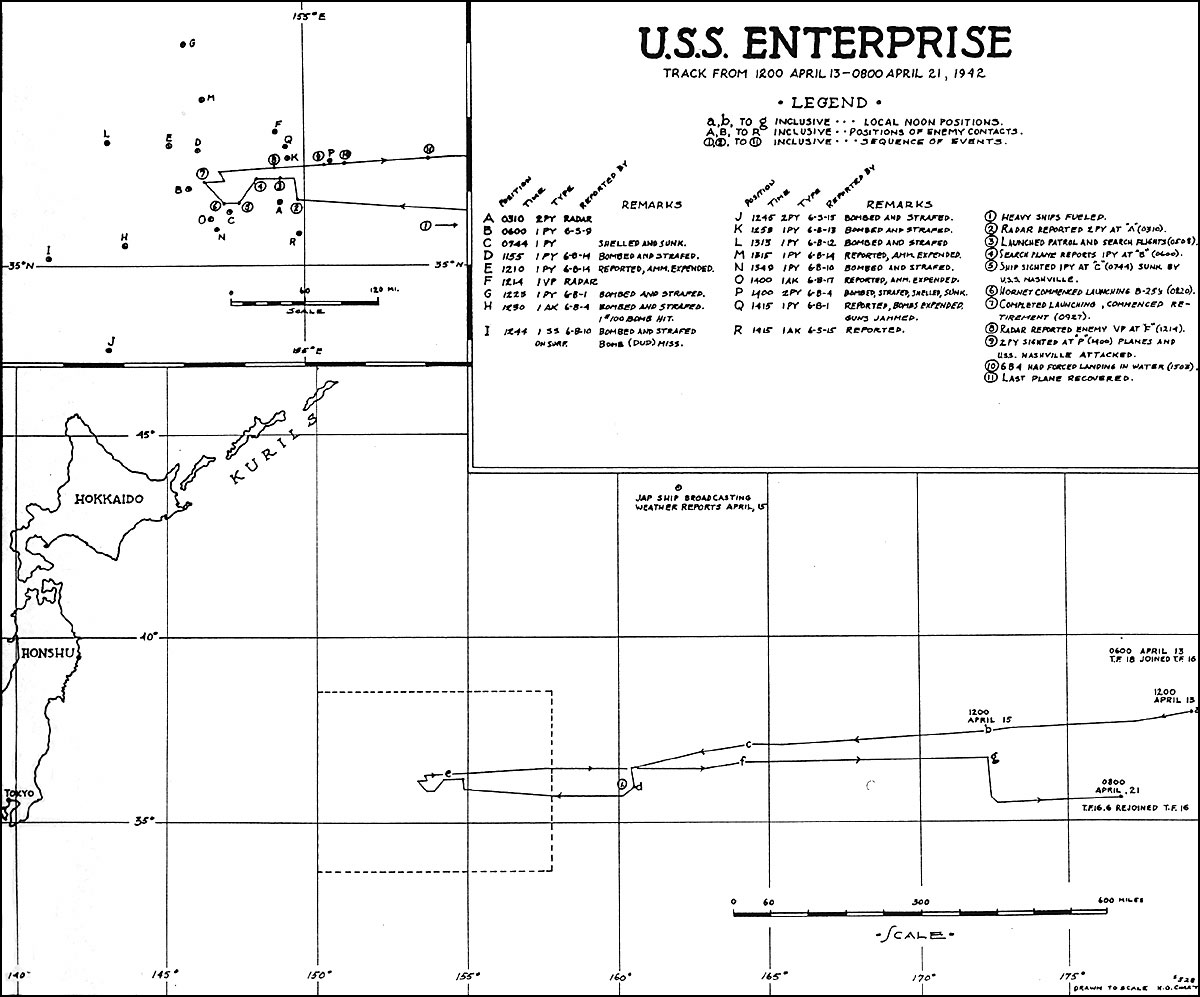April 18, 1942 – Task Force 16
consisting of USS Enterprise (VADM
William F. Halsey, Commander Carriers Pacific embarked), USS
Hornet (carrying 16 US Army
B-25's under command of Lcol James Doolittle) and cruisers
Northampton, Salt Lake City, Vincennes and
Nashville, heading
265, speed 20 knots, bound for Tokyo, distance about 700 miles.
Early
morning, unexpected events began to pop. In the words of the
participants:
Commanding
Officer, USS Enterprise:
- “At 0310 radar disclosed two enemy surface craft bearing 255°T., distance 21,000 yards, and at 0312 a light was seen approximately on that bearing. Ship went to General Quarters, set Material Condition Afirm and energized the degaussing gear. Course of the Force was changed to 350°T., and at 0341 the two enemy vessels went off the screen bearing 201°T., distance 27,000 yards. Our presence was apparently unnoticed by the enemy and a westerly course was resumed at 0415.
- “At 0508 fighter patrol and search flight were launched. At 0715 one search plane returned and, by message drop, reported sighting an enemy patrol vessel in Latitude 36° 04' North and Longitude 153° 10' East at 0558 and that he believed he had been seen. Later developments indicate that this vessel made the original contact report.
- “At 0744 an enemy patrol vessel was sighted bearing 221°T., distance approximately 10,000 yards. There was no doubt now that our force had been detected and almost certainly had been reported. NASHVILLE was ordered to sunk the patrol vessel by gunfire as the carriers turned into the wind (320°T., 26 knots); HORNET to launch Army B-25's for attack and ENTERPRISE to relieve patrol.s The first Army bomber was launched at 0820 approximately 650 miles from Tokyo, and the last one was off at 0921. At 0927 the Force commenced retirement on course 090°T., speed 25 knots.
- “At 1214 radar reported enemy patrol plane bearing 020°T., distance 70,000 yards. This plane came within 64,000 yards of our force but passed off the screen at 1228 bearing 314°T., distance 83,000 yards.
- “At 1400 two enemy patrol vessels were sighted and attacked by ENTERPRISE planes returning from search. One was sunk and the other damaged. By 1413 the enemy ship still afloat was in sight of our surface forces and NASHVILLE was ordered to attack and sink her. A white flag was broken in the enemy ship and after taking 5 prisoners, NASHVILLE sank her by gunfire. Apparently these two vessels were the same ones reported by radar at 0310.
“Our
force had been detected and almost certainly been reported...”
sounds like speculation. But in a secure communications space in
Enterprise, navy
Communications Technician Ray Rundle was monitoring Japanese
communications. He intercepted a warning message from a nearby patrol
boat. Rundle's report caused Halsey to act.
Halsey
had half of the US Navy's Pacific Fleet Carrier Force within range of
Japanese shore-based bombers. As of mid-April, Yamamoto had 11
aircraft carriers at his disposal compared to Halsey's 4. USS
Yorktown was operating in the
Coral Sea area, and USS Lexington was
in the shipyard at Pearl Harbor having her original 8-inch guns
removed and replaced with modern antiaircraft weapons. The fifth
Pacific Fleet carrier, USS Saratoga,
was in drydock in Bremerton, having her hull repaired from a Japanese
torpedo. The other aircraft carriers, the much smaller Ranger
and Wasp,
were in the Atlantic.
USS Essex
was under construction at Newport News, and wouldn't be launched for
three more months.
So
Halsey had to weigh any risk of losing a carrier very carefully. Here
is Halsey's account:
“The successful launching of the 16 Army bombers from the HORNET in unfavorable wind and sea conditions reflected great credit on the Army pilots and on the Commanding Officer of the HORNET.”
Here is the track of Task Force 16 to and from the launch point:



Sixteen planes, each with a five-man crew, took off that day. They reached their targets in the Tokyo area about six hours after launch, flying without an autopilot, using celestial navigation over water and visual navigation over land, then flew seven more hours to the vicinity of landing fields in China. They ran out of fuel before reaching the fields in unoccupied China, were flying after dark, and the fields were not transmitting homing signals. They had to ditch or bail out. All of the planes were lost, including one interned by the Soviet Union. Of the eighty crew members, 77 survived the raid, but Japanese executed three prisoners and one died of malnutrition and mistreatment.
I first learned of the raid by watching the movie, "Thirty Seconds Over Tokyo," starring Spencer Tracy and Van Johnson, at the Will Rogers Theater in Tulsa, Oklahoma in 1945.
It's still a great movie.
The raid took place four months and 11 days after Pearl Harbor.




No comments:
Post a Comment